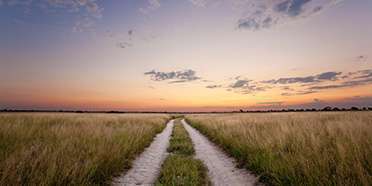- You are here:
- Home
- Countries & Parks
- Botswana Parks
- Khutse Game Reserve
- Reviews
- Expert Reviews
Expert Reviews – Khutse GR

Stephen is a travel writer and avid conservationist whose work appears in prestigious magazines such as Africa Geographic and Travel Africa.
2 people found this review helpful.
Dynamite comes in Small Packages
Although only a short hop from Gaborone, Khutse Game Reserve remains surprisingly remote and uncrowded, especially outside of school holidays and the peak safari season. One of a chain of parks that together protect vast swathes of the Kalahari, Khutse is a tiny reserve by Botswana standards, yet it embodies everything that makes the Kalahari so special: expansive landscapes, big blue skies, desert-adapted wildlife, wild camping spots, and a potent sense of wilderness. The sun-baked sands languish under drought-like conditions for most of the year, giving rise to a distinctive terrain of low dunes, sparse grasslands and the occasional scraggly tree, interspersed with more than 60 shimmering saltpans. It is not everyone’s cup of tea, but I love the place.

Mark is a travel writer who grew up in Africa and has written over 700 titles for Condé Nast Traveller, Travel Africa, BBC Wildlife and others.
3 people found this review helpful.
Khutse is the most accessible part of the Botswana Kalahari from South Africa
This was the starting point for our month-long expedition across the Kalahari and Okavango to Vic Falls and it was a perfect introduction. Despite hearing their roars at night and finding the tracks of a pair of nomad male lions in the morning we did not manage to spot the Khutse lions (which served to heighten anticipation for later sightings deeper into the Kalahari. The name means ‘you kneel to drink’ in San and gives a pretty good idea of how dry this area can be. The track north from here into the Kalahari makes for an interesting experience; set your engine to ticking over in third gear and you find that you can almost travel on full autopilot with the wheels running as if on tracks in the rutted sand. (Careful you don’t doze off though – there is a tree and an unexpected left turn about 6 hours up the route!)

Anthony is a photographer and writer for travel magazines and Lonely Planet, including the guides to Kenya and Botswana & Namibia.
3 people found this review helpful.
Khutse: The Other Kalahari
Part of the chain of parks that protect vast swathes of the Kalahari, Khutse Game Reserve abuts the southern boundary of the Central Kalahari Game Reserve. I love this reserve because it’s the smallest, most accessible slice of the Kalahari but has everything that makes the Kalahari so evocative – up to 60 shimmering salt pans that draw surprising numbers of herbivores in search of salt and water, male lions with their extravagantly flowing black manes and remote trails that cut deep into the heart of the desert. And you never know what you might see – I saw a young leopard drinking from a waterhole around midday. And for wildlife possibilities away from the (albeit moderate) crowds, I prefer the less-frequented Moreswe pan in the reserve’s far southwest or the Khwankwe Pan in the north (actually part of the Central Kalahari Game Reserve) to the more popular Molose waterhole.

Emma is an award-winning travel writer for Rough Guides, National Geographic Traveller, Travel Africa magazine and The Independent.
4 people found this review helpful.
A taste of the Kalahari, within reach of the city
This small, southern extension of the Central Kalahari Game Reserve is close enough to Gaborone to be popular with city-dwellers and overseas visitors alike. I think to get a true sense of the Kalahari wilderness it’s best to head deeper into the Central Kalahari Game Reserve, but nonetheless Khutse offers a satisfying taste of the region’s distinctive combination of habitats – dunes, salt pans and grasslands. This is also a good place to learn about San Bushman traditions and culture, by booking a bushwalk with one of the San guides living on the periphery of the reserve. You’ll definitely see springbok and oryx in the reserve, and there’s a reasonable chance of seeing black-backed jackals, lions, leopards, cheetahs and smaller cats, too.


 Botswana Parks
Botswana Parks